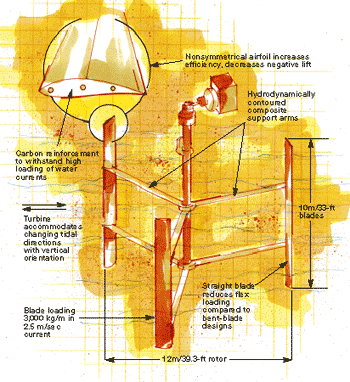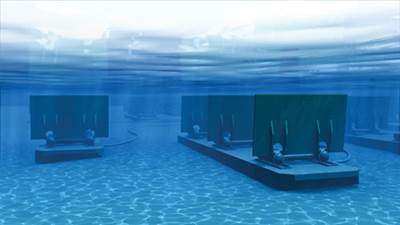Composites tap tide energy
Composites-enabled tidal stream energy projects lead the way as new forms of hydrokinetic power generation move toward commercialization.
Hydrokinetic power is not new: Turbines beneath hydroelectric dams on many of the world’s rivers began delivering electric power to national grids early in the last century. But in the next 20 years, hydrokinetic power drawn from the earth’s oceans and rivers by other means could account for more than 10 percent of the world’s global electricity market. Harnessed from ocean wave, tidal stream, ocean and river current and ocean thermal resources, these new renewable energy resources are poised for major growth over the next five years. In fact, more than 300 hydrokinetic projects are currently underway around the world, according to Pike Research (Boulder, Colo.), which points to Canada, the U.K. and the U.S. as the likely leaders in widespread commercialization.
Most promising are projects that exploit the energy in ocean tides and waves. “The outlook for wave and tidal energy, particularly in the U.K., is very promising,” says Marcus Royle, head of Strategic Business Development at composite materials supplier Gurit UK (Isle of Wight, U.K.). “The last 12 to 24 months have seen the industry move forward in great leaps with the deployment of a number of devices at significant scale and with engineering underway for several more commercial-scale projects,” he says, noting the “growing investment interest from large multinational industrial organizations.”
There are several hotbeds of tidal and wave energy development in the world, with more on the horizon. Established test-bed sites include the European Marine Energy Centre (EMEC) in Scotland’s Orkney Islands; the New and Renewable Energy Centre (NaREC) in England; the Fundy Ocean Research Centre for Energy (FORCE) site in the Bay of Fundy (Nova Scotia, Canada); Galway Bay in Ireland, and Nissum Bredning in Denmark.
This activity is well in line with the U.K. government’s recently released Offshore Valuation report, says Royle, which predicts that wave and tidal energy will contribute up to 51 gigawatts (GW) of capacity to the U.K. electrical grid over the next 40 years. “You can see that we have significant technology and manufacturing industries within our reach,” he adds.
Globally, installed capacity of hydrokinetic energy is predicted to reach 3.8 GW by 2015, says Global Industry Analysts Inc. (San Jose, Calif.), which has published a market report on ocean energy. In a similar study, Pike Research contends that if ocean energy trial projects are successful in the next few years, commercial ocean-energy production worldwide could take an enormous jump to 200 GW of installed power generation capacity as early as 2025.
“The ocean energy business is right on the cusp,” contends Pike’s managing director Clint Wheelock, explaining that it is “still in a proof-of-concept phase for several key technologies, and the outcome of early pilot projects will determine whether wave energy, tidal energy and other technologies are ready for primetime.” But Pike’s report also warns that “if early projects have limited success, are too costly or do not enjoy a favorable public policy regime, the marine renewable sector could be relegated to niche status, reaching no more than 25 GW in global capacity by 2025.”
Material selection will play a critical role in success (or lack of same), and composites — time-tested in both marine and wind applications — are a natural fit for harsh, corrosive salt water environments.
“Virtually all of the wave and tidal generation concepts currently active can, or do, utilize composites in some form due to corrosion-resistance, fatigue-life and durability requirements,” confirms Gurit’s Royle, whose company has supplied not only materials technology but also structural-engineering and device-prototyping services to ocean-energy companies for several years.
Of the vast array of competing hydrokinetic energy-capture concepts, however, only a handful, to date, have proven themselves on a commercial scale. On that front, tidal energy is leading the way to commercial hydrokinetic energy, with wave-energy development following close behind (see the “Wave energy conversion” sidebar below or click on its title uner "Editor's Picks," at right). There are a wide range of tidal projects underway, with a variety of underlying technologies at play, including axial flow turbine systems (both horizontal and vertical axis), cross-flow turbines and oscillating hydrofoil systems — each making use of composites.
Predictable energy from earth’s tides
The rise and fall of Earth’s sea level creates a power source that is predictable in both timing and force, allowing energy utilities to accurately forecast the amount of power that will be generated by a tidal device at any given time. Notably, the same cannot be done for wind turbines. Composites are particularly well suited, therefore, to tidal energy, says Royle, where “low weight is a bigger driver and the loads experienced are more predictable and allow the use of a more refined structural design.”
Predictability, however, does not eliminate the challenges associated with submerging energy-generating devices into attractively strong tidal streams. The Bay of Fundy, for example, produces huge tidal currents, pushing more than 100 billion tons of water out of the bay with each tide. According to tidal energy producer Marine Current Turbines (MCT, Bristol, U.K.), when the tide flows through the 6-km/3.7-mile wide narrows between Cape Split and Parrsboro, Nova Scotia, it moves at speeds of up to 14 kmh/8.7 mph.
Given the significant forces involved, tidal turbines must be engineered to stringent standards, the parameters of which concept developers are still discovering. OpenHydro (Dublin, Ireland), for example, recently suffered a setback in the bay when two of the glass-fiber reinforced composite blades in one of its open-center turbine tidal systems broke. The company and its partner in the Bay of Fundy project, Nova Scotia Power, plan to remove the damaged turbine this fall, repair it and then redeploy it in 2011.
Rated at 1 megawatt (MW), the commercial scale turbine was stationed at the FORCE deployment site in Nova Scotia. OpenHydro has conducted extensive testing of its turbine design at the EMEC in Scotland, where it was the first to install a tidal turbine and subsequently connect and generate electricity for the U.K. national power grid, according to the company.
Its horizontal-axis turbine design employs glass-reinforced composite blades and a self-contained rotor with a solid-state permanent magnet generator encapsulated within the outer rim.
The turbine is housed within a ductwork, creating a Venturi effect to concentrate the flow of water and produce a pressure differential. In lieu of a central axle, a stator is used to keep the rotors fixed. Combined, the turbine and gravity base, which holds the device on the seabed, measure 16m/52.5 ft wide. Its blades measure approximately 1m/3.3 ft wide.
Reportedly, OpenHydro is testing an array that will anchor three smaller turbines on a triangular frame off of the seabed.
Learning from wind power
Horizontal-axis underwater turbines, such as OpenHydro’s open-center turbine and MCT’s SeaGen, operate in much the same way a wind turbine does. Wind power system design, therefore, provides a good working model for a tidal turbine system. However, water is, at sea level, nearly 800 times more dense than air. Although this creates immensely strong tidal currents that offer the potential for significantly greater energy output than that of a similarly sized offshore wind turbine system, the dense water also magnifies the shear, bending and torque loads faced by tidal blades. And, unlike wind turbines, tidal rotors do not exhibit centrifugal release, the result when centrifugal force relieves blade bending stress. Therefore, submerged turbine blade designs feature some important differences.
According to MCT, the SeaGen tidal turbines “work much like submerged windmills.” Each system employs two 16m/52.5-ft diameter pitch-controlled axial-flow rotors similar to those used in the wind industry. Composite blades are attached to metal rotor hubs and shafts that sit on either end of a composite-and-steel cross-arm (see photo, at right). Suspended on a piling that is embedded in the seafloor, the cross-arm and rotors can be raised out of the water for maintenance. Like many wind systems, tidal turbine rotor blades also can be pitched to limit the power to a preselected “rated power” at times when high velocities are experienced, to reduce loads on the blades, rotor and generator works and turbine structure. Unlike wind systems, SeaGen’s rotor blades add a patented technology that enables blades to pitch through 180°, allowing for operation during ebb and the flood tides, without having to reposition the entire turbine. Further, the SeaGen rotors operate at varying water depths during the ebb/flow cycle, exposing the blades to cyclic static-pressure variation. To counteract these effects, blade spars are hollow, and during operation, they are filled with seawater to equalize the pressure inside and outside the rotor blade. According to MCT’s patent, at the depths SeaGen operates, filling the void with a lightweight material that is not easily compressible — such as the foamed plastic often used as core material in composite structures — could cause the surface of the rotor-blade to flex under the influence of the cyclic static pressure variations. Over time, the blade skin could suffer from fatigue, with risk of delamination.
Aviation Enterprises Ltd. (AEL, Lambourn Woodlands, Berkshire, U.K.) manufactures SeaGen’s carbon- and glass-fiber/epoxy blade assembly, which includes a fully integrated fiber-optic stress sensing system designed to continuously monitor performance. The 8m/26.2-ft long, 65-mm/2.6-inch thick structural spars are manufactured using VTM260 carbon/epoxy prepreg from Advanced Composites Group Ltd. (Heanor, Derbyshire, U.K.). The composite spar is reportedly bonded to carbon ribs and enveloped in E-glass-reinforced epoxy.
Earlier this year, the SeaGen commercial prototype logged 1,000 hours of operation in Northern Ireland’s Strangford Narrows. At the time, the 1.2-MW tidal current turbine had delivered 800 MW of power into the U.K. national power grid with a reported capacity factor of 66 percent. MCT says the system is capable of delivering nearly 10 megawatt hours (MWh) per tide — 6,000 MWh per year.
Among other projects, MCT plans to deploy a tidal farm off Brough Ness on the southern tip of the Orkney Islands. The project calls for 66 SeaGen tidal turbines, installed in three phases over a four-year period. The first phase of turbines is to be deployed during 2017. MCT hopes to have all 66 turbines operational by 2020 and predicts this array could have a total generating capacity of 99 MW.
All-composite cross-flow turbine
In contrast, the underwater turbine design employed by Ocean Renewable Power Co. (ORPC, Portland, Maine) uses a cross-flow design. The company’s Turbine Generator Unit (TGU) comprises an all-composite cross-flow turbine system and a composite-and-steel support frame, the latter built by U.S. Windblade (Bath, Maine). The turbine incorporates a carbon fiber/E-glass fiber hybrid primary shaft, and disks, rings and helical foils constructed of E-glass-reinforced vinyl ester laminate.
According to Monty Worthington, ORPC’s director of project development in Alaska, who spoke earlier in the year at the Alaska Energy Authority (AEA) Hydrokinetic Technical Conference, the cross-flow turbines spin at 30 to 60 rpm, generating low-rpm/high-torque energy that is converted by a permanent-magnet generator. In tidal applications, there is no need to reposition the turbines, because they will continue to turn in the same direction regardless of the direction of water flow.
The massive frame, which measures 46 ft long, 14 ft wide, and 11 ft tall (14 by 4.3 by 3.4m), was constructed by Stillwater Metalworks (Bangor, Maine) with composite structures supplied by Harbor Technologies (Brunswick, Maine), an experienced marine composites manufacturer, particularly in the glass-reinforced plastic (GFRP) pilings arena. Custom Composites Technologies (Bath, Maine) also was involved in the TGU development.
Earlier this year, ORPC deployed its beta-version TGU in Cobscook Bay off the coast of Eastport, Maine. Suspended from the Energy Tide 2 barge, the 60-kilowatt (kW) device demonstrated its technical feasibility by generating electricity for the Eastport Coast Guard. (An earlier prototype TGU — tested in the Bay of Fundy for a year — was constructed primarily of steel and wood components.)
ORPC plans to have a commercial-scale TGU, given the name TidGen Power System, connected to the electrical grid by the end of the year. By late 2011, this initial 5-MW pilot project is expected to generate “enough electricity to power every home and business in the Eastport area,” says the company. Looking to the future, ORPC hopes to expand the project to supply energy to all of Downeast Maine, and believes tidal energy could be commercially viable by 2015.
Like many tidal-energy developers, ORPC is looking to leverage its experience into other areas of hydrokinetic energy. According to Worthington, the beta TGU is the core of what will be three hydrokinetic power systems: TidGen (bottom mounted in shallow tides), RivGen (bottom-mounted for river applications) and OCGen (floating modules that consist of stacked TGUs for deep tidal and offshore ocean-current applications). The company plans to begin initial commercial installations with gravity-based foundations.
Riding the tides through oscillation
Oscillating turbines, as the term suggests, do not rotate. Instead they rely on the movement of hydrofoils, which are raised and lowered by the tidal stream. In Pulse Tidal’s (Sheffield, U.K.) system, the oscillating hydrofoils lie horizontally in the water and sweep up and down as they change pitch, driving a generator. Advantages here include the fact that the lengths of the horizontal foils are not limited by water depth, allowing the company to install commercial-scale devices (1 MW and larger) in shallow water. This offers easier access for deployment and maintenance and has the potential to limit the length (and therefore expense) of the transmission cable that tethers the turbine to a land-based power grid.
In 2009, Pulse Tidal submerged a 100-kW prototype, called Pulse-Stream 100 (PS100) into the shallow water (9m/29.5 ft deep) at the mouth of the River Humber in the U.K. Electricity generated by the system was exported to Millennium Chemicals, which sits on the south bank of the estuary.
Currently, the Pulse Tidal team is working to install a commercial-scale system close to the shore at Kyle Rhea, the narrow, fast-flowing straits between the Isle of Skye and the Scottish mainland. The initial commercial demonstrator is expected to begin producing 1.2 MW of electricity in 2012. Once proven, the system will be enhanced: Power output can be ramped up to 9.6 MW by stringing eight devices together.
The demonstrator design calls for four composite hydrofoils, or blades, each measuring approximately 20m/65.6 ft in length, connected to a flat base that sits on the seabed. The blades will be engineered and manufactured by Gurit, and will employ the company’s trademarked epoxy SPRINT or prepreg technology, already proven in the manufacture of wind turbine blades and marine craft. Due to the high demands on the structure caused by loads and the operating environment, Gurit’s Royle expects the main load-bearing components to require thick monolithic laminates comparable to those seen on much larger wind turbine blades. Initial blades will contain instrumentation to verify actual loads. The accumulated load data will enable optimization of the system in future iterations.
“The fatigue life and extreme load requirements of the foils dictate that composite materials are the only practical choice,” explains Royle. “An equivalent metallic structure would pay a significant weight penalty, placing very high loads on the rest of the structure with the resultant effect on weight, cost and hydrodynamic drag.”
A number of other companies are developing tidal stream energy concepts — too many to cover here — each applying its own unique spin on the underlying technologies. Minesto AB (Göteborg, Sweden and London, U.K.), for instance, is developing an underwater kite concept known as Deep Green, in which a shrouded horizontal-axis turbine rides under a wing with a rudder that is tethered 100m/328 ft above the sea floor (see photo, at right). Marstrom Composites (Västervik, Sweden) produces the composite components used in the system.
Regardless of the technology behind the tidal energy device, it is clear that the hydrokinetic energy in tides can be harnessed as a source of electric power. What’s left to be determined is whether or not these systems can be efficient, scalable, and, most importantly, cost-effective, while also offering long-term survivability and reliable operation. Without doubt, material selection will be critical as these companies move forward. Almost certainly, composites in one form or another will emerge as the blade materials of choice. For many developers, the primary challenge now is not materials, but rather getting enough units into the water to reduce costs to a point where tidal energy is competitive in the commercial energy marketplace.
Related Content
Collins Aerospace to lead COCOLIH2T project
Project for thermoplastic composite liquid hydrogen tanks aims for two demonstrators and TRL 4 by 2025.
Read MoreMingYang reveals 18-MW offshore wind turbine model with 140-meter-long blades
The Chinese wind turbine manufacturer surpasses its 16-MW platform, optimizes wind farm construction costs for 1-GW wind farms.
Read MoreRTM, dry braided fabric enable faster, cost-effective manufacture for hydrokinetic turbine components
Switching from prepreg to RTM led to significant time and cost savings for the manufacture of fiberglass struts and complex carbon fiber composite foils that power ORPC’s RivGen systems.
Read MoreDrag-based wind turbine design for higher energy capture
Claiming significantly higher power generation capacity than traditional blades, Xenecore aims to scale up its current monocoque, fan-shaped wind blades, made via compression molded carbon fiber/epoxy with I-beam ribs and microsphere structural foam.
Read MoreRead Next
Composite tidal turbine to harness ocean energy
Glass, carbon composites are the materials of choice for system that harvests energy from tidal currents.
Read MoreWave-energy conversion
Although wave-energy converters (WECs) lag a few years behind tidal energy systems in terms of commercial viability, there is a lot of action on the development front.
Read MorePlant tour: Daher Shap’in TechCenter and composites production plant, Saint-Aignan-de-Grandlieu, France
Co-located R&D and production advance OOA thermosets, thermoplastics, welding, recycling and digital technologies for faster processing and certification of lighter, more sustainable composites.
Read More
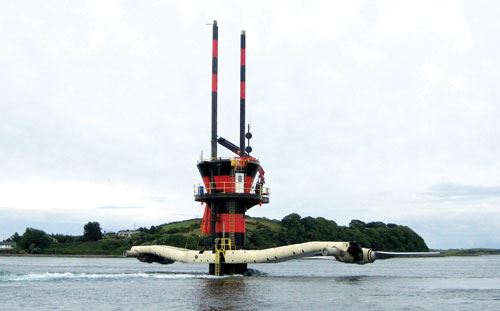
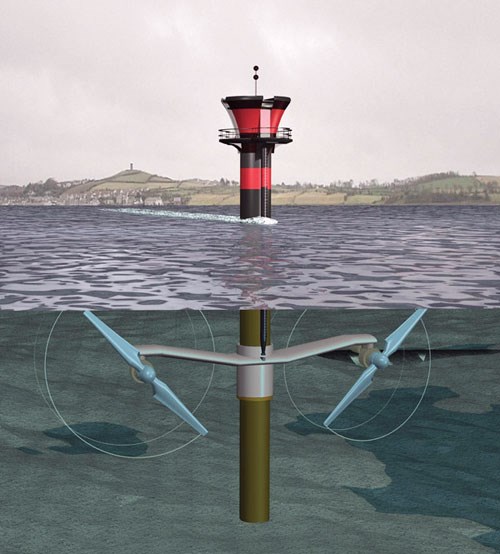
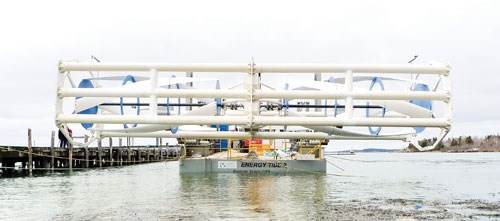
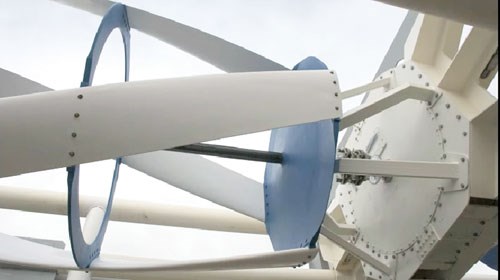
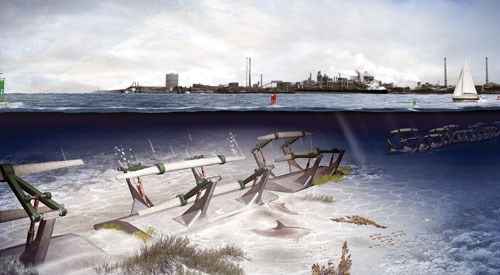
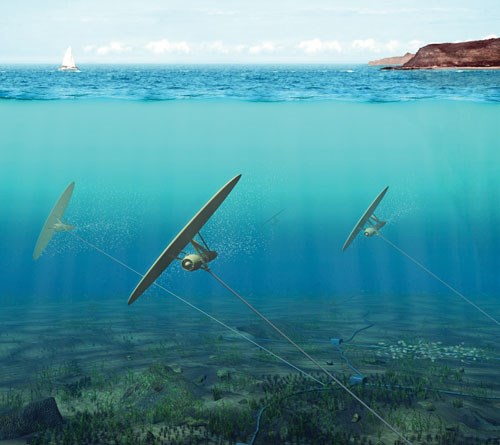
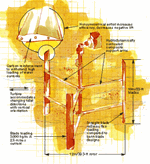










.jpg;maxWidth=300;quality=90)





